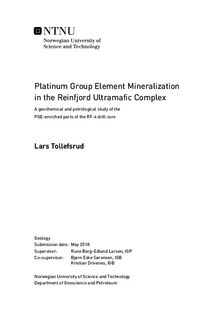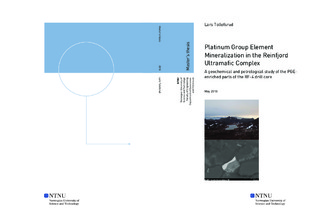| dc.description.abstract | The Reinfjord Ultramafic Complex (RUC), a part of the Seiland Igneous Province (SIP), is located in Nord-Troms, Norway. The RUC constitutes parts of deep seated magmatic conduit system that comprises a low tenor PGE-reef. In the RF-4 drill core, the reef is located at a depth of approximately 62 m, where the Pd+Pt concentration reaches around 0.8 ppm. This thesis places its emphasis on investigating the PGE mineralization of the RF-4 drill core, in order to obtain knowledge regarding the formation mechanisms of the reef. The thesis also compares the results with the mineralization found in the RF-1 drill core. Chemical data was provided by ICP spectrometry, SEM and EPMA, while preliminary investigations was done by optical microscopy.
The PGE host rock in RF-4 is a dunite, containing mostly olivine, with minor clinopyroxene and orthopyroxene. Interstitial carbonates and amphibole is also present. The RF-4 drill core revealed a wide variety of PGM's, where bismuthotellurides, arsenides and sulfurarsenides are the most common phases. Other phases comprise antimonides and PGE alloys. The PGM's are often BMS associated, where both pentlandite and pyrrhotite are common hosts. The presence of the PGE-arsenides-and sulfurarsenides, set the mineralization in RF-4 apart from that of RF-1. Possible scenarios explaining the differences in PGM assemblage are localized gain of As from surrounding rocks, removal by hydrothermal fluids or vertical displacement of As-rich zones due to tectonics.
The author suggest that the PGM's formed from sulfide fractionation, and the concentration process is thus magmatic. Further, the author propose the possibility of PGM's exsolving from an iss, due the PGM's often showing an affinity to Cu-rich pyrrhotite. PGM's can also be found associated with serpentine, sometimes showing remainders of BMS, indicating high degrees of serpentinization. Serpentinization is also responsible for the breakdown of chalcopyrite, leading to the formation of native Cu. Stability field calculations with constant bulk composition a.k.a a pesudosection was done for a mineral assemblage comprising amphibole, orthopyroxene, olivine and magnesite, which represents a secondary volatile phase. The model propose that re-mobilization of PGE and Au could happen at high P ($>6$ bar) and mid-to-high T ($>800$ K) conditions. Pd would be more soluble in the fluid compared to Pt, and the Pd-cluster in RF-1 could thus be the result of such processes. | |

